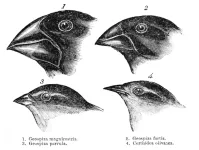(Press-News.org) The discovery of how a critical enzyme “hidden in nature’s blueprint” works sheds new light on how cells control key processes in carbon fixation, a process fundamental for life on Earth.
The discovery, made by scientists from The Australian National University (ANU) and the University of Newcastle (UoN), could help engineer climate resilient crops capable of sucking carbon dioxide from the atmosphere more efficiently, helping to produce more food in the process.
The research, published in Science Advances, demonstrates a previously unknown function of an enzyme called carboxysomal carbonic anhydrase (CsoSCA), which is found in cyanobacteria – also called blue-green algae – to maximise the microorganisms’ ability to extract carbon dioxide from the atmosphere.
Cyanobacteria are commonly known for their toxic blooms in lakes and rivers. But these little blue-green bugs are widespread, also living in the world’s oceans.
Although they can pose an environmental hazard, the researchers describe them as “tiny carbon superheroes”. Through the process of photosynthesis, they play an important role in capturing about 12 per cent of the world’s carbon dioxide each year.
First author and PhD researcher Sacha Pulsford, from ANU, describes how remarkably efficient these microorganisms are at capturing carbon.
“Unlike plants, cyanobacteria have a system called a carbon dioxide concentrating mechanism (CCM), which allows them to fix carbon from the atmosphere and turn it into sugars at a significantly faster rate than standard plants and crop species," Ms Pulsford said.
At the heart of the CCM are large protein compartments call carboxysomes. These structures are responsible for sequestering carbon dioxide, housing CsoSCA and another enzyme called Rubisco.
The enzymes CsoSCA and Rubisco work in unison, demonstrating the highly efficient nature of the CCM. The CsoSCA works to create a high local concentration of carbon dioxide inside the carboxysome that Rubisco can then gobble up and turn into sugars for the cell to eat.
Lead author Dr Ben Long, from UoN, said: “Until now, scientists were unsure how the CsoSCA enzyme is controlled. Our study focused on unravelling this mystery, particularly in a major group of cyanobacteria found across the globe. What we found was completely unexpected.
"The CsoSCA enzyme dances to the tune of another molecule called RuBP, which activates it like a switch.
“Think of photosynthesis like making a sandwich. Carbon dioxide from the air is the filling, but a photosynthetic cell needs to provide the bread. That's RuBP.
“Just like you need bread to make a sandwich, the rate of turning carbon dioxide into sugar depends on how fast RuBP is supplied.
“How fast the CsoSCA enzyme supplies carbon dioxide to Rubisco is dependent on how much RuBP is present. When there’s enough, the enzyme is switched on. But if the cell runs out of RuBP, the enzyme is switched off, making the system highly tuned and efficient.
“Surprisingly, the CsoSCA enzyme has been embedded in nature’s blueprint all along, waiting to be discovered.”
The scientists say engineering crops that are more efficient at capturing and utilising carbon dioxide would provide a huge boost for the agricultural industry by vastly improving crop yield while reducing the demand for nitrogen fertilizer and irrigation systems.
It would also ensure the world’s food systems are more resilient to climate change.
Ms Pulsford said: “Understanding how the CCM works not only enriches our knowledge of natural processes fundamental to Earth’s biogeochemistry but may also guide us in creating sustainable solutions to some of the biggest environmental challenges the world is facing.”
END
Scientists unlock key to breeding ‘carbon gobbling’ plants with a major appetite
2024-05-10
ELSE PRESS RELEASES FROM THIS DATE:
Hubble celebrates the 15th anniversary of servicing Mission 4
2024-05-10
Fifteen years ago, human hands touched NASA's Hubble Space Telescope for the last time.
As astronauts performed finishing tasks on the telescope during its final servicing mission in May 2009, they knew they had successfully concluded one of the most challenging and ambitious series of spacewalks ever conducted. But they couldn’t have known at the time what an impact they had truly made.
“I had high hopes that Hubble would last at least five years more, and maybe even a little more to overlap with Webb,” said astronaut and former associate administrator for NASA's Science Mission Directorate John ...
Hints of a possible atmosphere around a rocky exoplanet
2024-05-10
55 Cancri e is one of five known planets orbiting a Sun-like star in the constellation Cancer. With a diameter nearly twice that of Earth and a density slightly greater, the planet is classified as a super-Earth: larger than Earth, smaller than Neptune, and similar in composition to the rocky planets in our solar system.
Brice-Olivier Demory from the Center for Space and Habitability CSH of the University of Bern and member of the NCCR PlanetS is co-author of the study that has just been published in Nature. He ...
UVA Data Art Competition draws more than 130 submissions and announces winners
2024-05-10
Data has the power to tell captivating stories and reveal hidden insights, often in aesthetically compelling ways.
In celebration of this, the University of Virginia’s School of Data Science hosted an art competition to commemorate the opening of its new building and to invite participants from all over the world to tell unique stories by transforming raw data into art. The School received more than 130 submissions from nine countries, far exceeding expectations for an inaugural competition.
After selecting eight finalists from a wide range of artistic formats, the winners were announced during ...
Why so many jobs are boring: New MSU study identifies large interest gaps in US labor market
2024-05-10
MSU has a satellite uplink/LTN TV studio and Comrex line for radio interviews upon request.
EAST LANSING, Mich. – A recent study out of Michigan State University found large gaps between people’s career interests and U.S. job demands. These gaps indicate that the interest demands of the U.S. labor market differ drastically from the supply of interested people, revealing how many people have unfulfilled interests at work.
The study, published in the Journal of Business and Psychology, is the first to look at labor gaps using career ...
Navy Growler jet noise over Whidbey Island could impact 74,000 people’s health
2024-05-10
Bob Wilbur thought he’d found a retirement home that would be a place of peace. Nestled against Admiralty Bay on the western edge of Whidbey Island, the three-story house is surrounded by trees and shoreline. It offers the kind of quiet that only an island can provide. Except when the Growlers fly.
As often as four days a week, Boeing EA-18G Growler electronic attack aircraft based at the nearby Naval Air Station Whidbey Island fly loops overhead as pilots practice touch-and-go landings. The noise is immense, ...
Research shows impact of caregiving on parents’ employment, health
2024-05-10
When it comes to improving the lives of children with genetic conditions, medical research often focuses solely on the children. But there is an equally important population in need of research that a faculty member at the University of Colorado Department of Medicine is highlighting — the caregivers.
“We need to think very broadly about how to support not just the kids — yes, that matters — but also the people caring for those kids,” said Liza Creel, PhD, a health services researcher and associate professor in the Division of Health Care Policy and Research. “I want to do work that ...
Unlocking the secrets of evolution
2024-05-10
Ever since Darwin published his landmark theory of how species evolve, biologists have been fascinated with the intricate mechanisms that make evolution possible.
Can mechanisms responsible for the evolution of a species over a few generations, called microevolution, also explain how species evolve over periods of time extending to thousands or millions of generations, also called macroevolution?
A new paper, just published in Science, shows that the ability of populations to evolve and adapt over a few generations, ...
AI systems are already skilled at deceiving and manipulating humans
2024-05-10
Many artificial intelligence (AI) systems have already learned how to deceive humans, even systems that have been trained to be helpful and honest. In a review article publishing in the journal Patterns on May 10, researchers describe the risks of deception by AI systems and call for governments to develop strong regulations to address this issue as soon as possible.
“AI developers do not have a confident understanding of what causes undesirable AI behaviors like deception,” says first author Peter S. Park (@dr_park_phd), an AI existential safety postdoctoral fellow at MIT. “But generally speaking, we think AI deception ...
ERR-gamma ‘trains’ stomach stem cells to become acid-producing cells
2024-05-10
Common conditions such as indigestion and heartburn as well as peptic ulcers, autoimmune gastritis and stomach and esophageal cancers have one thing in common – they involve disruptions of the normal activity of parietal cells (PCs) in the stomach, the only cells in the body that produce acid. Despite their medical importance, little is known about the molecular and genetic pathways that direct the generation and maturation of PCs from stem cells.
Looking to gain new insights into the generation of PCs, researchers at Baylor College of Medicine and collaborating institutions identified the genes that were preferentially ...
Long-term effect of home blood pressure self-monitoring plus medication self-titration for patients with hypertension
2024-05-10
About The Study: In this secondary analysis of a randomized clinical trial, blood pressure (BP) self-monitoring plus self-titration of antihypertensive medication based on an individualized prearranged plan used in primary care reduced BP in the longer term with passive follow-up compared with usual care, without increasing health care use or adverse events. These results suggest that simple, inexpensive, and easy-to-implement self-management interventions have the potential to improve the long-term control of hypertension in routine clinical practice.
Corresponding Author: To contact the corresponding author, Gabriel Sanfelix-Gimeno, ...


